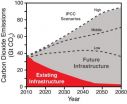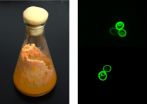(Press-News.org) We're all familiar with birds that are as comfortable diving as they are flying but only one family of fish has made the reverse journey. Flying fish can remain airborne for over 40s, covering distances of up to 400m at speeds of 70km/h. Haecheon Choi, a mechanical engineer from Seoul National University, Korea, became fascinated by flying fish when reading a science book to his children. Realising that flying fish really do fly, he and his colleague, Hyungmin Park, decided to find out how these unexpected fliers stay aloft and publish their discovery that flying fish glide as well as birds on 10 September 2010 in The Journal of Experimental Biology at http://jeb.biologists.org.
But getting hold of flying fish to test in a wind tunnel turned out to be easier said than done. After travelling to Japan to try to buy fish from the world famous Tsukiji fish market, the duo eventually struck up a collaboration with the National Federation of Fisheries Cooperatives of Korea. Park went fishing in the East Korean Sea, successfully landing 40 darkedged-wing flying fish. Selecting five similarly sized fish, Park took them to the Korean Research Centre of Maritime Animals, where they were dried and stuffed, some with their fins extended (as in flight) and one with its fins held back against the body, ready to test their aerodynamics in the wind tunnel. Fitting 6-axis force sensors to the fish's wings and tilting the fish's body at angles ranging from degrees to 45 degrees, Park and Choi measured the forces on the flying fish's fins and body as they simulated flights.
Calculating the flying fish's lift-to-drag ratios – a measure of the horizontal distance travelled relative to the descent in height during a glide – Choi and Park found that the flying fish performed remarkably well: gliding better than insects and as well as birds such as petrels and wood ducks. And when they analysed how the fish's lift-to-drag ratio changed as they varied the tilt angle, the duo found that the ratio was highest and the fish glided furthest when they were parallel to the surface, which is exactly what they do above the ocean. Measuring the airborne fish's pitching moment, the duo also found that the fish were very stable as they glided. However, when they analysed the stability of the fish with its fins swept back in the swimming position it was unstable, which is exactly what you need for aquatic manoeuvrability. So flying fish are superbly adapted for life in both environments.
Knowing flying fish always fly near the surface of the sea, Choi and Park then decided to find out if the fish derived any benefit from the aerodynamic effect of flying close to the surface. Lowering the fish's height in the wind tunnel they found that the lift-to-drag ratio increased as the fish models 'glided' near the floor. And when Park replaced the solid surface with a tank of water, the lift to drag ratio rose even more, allowing the fish to glide even further. So, gliding near the surface of the sea helps the fish to go further.
Finally, Choi and Park directly visualised the air currents passing around the flying fish's wings and body. Blowing streams of smoke over the fish, the duo saw jets of air accelerating back along the fish's body. Park explains that the tandem arrangement of the large pectoral fin at the front and smaller pelvic fin at the back of the fish's body accelerates the air flow towards the tail like a jet, increasing the fish's lift-to-drag ratio further and improving its flying performance even more.
Having shown that flying fish are exceptional fliers, Choi and Park are keen to build an aeroplane that exploits ground effect aerodynamics inspired by flying fish technology.
###
IF REPORTING ON THIS STORY, PLEASE MENTION THE JOURNAL OF EXPERIMENTAL BIOLOGY AS THE SOURCE AND, IF REPORTING ONLINE, PLEASE CARRY A LINK TO: http://jeb.biologists.org
REFERENCE: Park, H. and Choi, H. (2010). Aerodynamic characteristics of flying fish in gliding flight. J. Exp. Biol. 213, 3269-3279.
This article is posted on this site to give advance access to other authorised media who may wish to report on this story. Full attribution is required, and if reporting online a link to jeb.biologists.com is also required. The story posted here is COPYRIGHTED. Therefore advance permission is required before any and every reproduction of each article in full. PLEASE CONTACT permissions@biologists.com
THIS ARTICLE APPEARS IN THE JOURNAL OF EXPERIMENTAL BIOLOGY ON 10 September 2010. EMBARGOED UNTIL FRIDAY, 10 September 2010, 00.00 HRS EST (05:00 HRS GMT)
Flying fish glide as well as birds
2010-09-10
ELSE PRESS RELEASES FROM THIS DATE:
Lack of trust in hospitals a major deterrent for blood donation among African-Americans
2010-09-10
Disparities in healthcare between races exist in the United States. A new study published in the journal Transfusion explores why African Americans donate blood at lower rates than whites. The findings reveal that there is a significant distrust in the healthcare system among the African American community, and African Americans who distrust hospitals are less likely to donate.
Led by Beth H. Shaz, MD, Chief Medical Officer of the New York Blood Center in New York, New York, researchers created a survey to explore reasons for low likelihood of blood donation in African ...
BEK Communications Looks to Mariner's xVu Service to Better Manage Local IPTV Programming
2010-09-10
BEKTV utilizing industry leading service assurance tool to gain viewership insight
Fiber to the Home (FTTH) Conference, Las Vegas, NV, September 9th, 2010: BEK Communications, the innovative telecommunications company serving south-central North Dakota, announced today their use of xVu as a means of gaining improved insight of their local programming. A key element of BEK's strategy as a multi-faceted telecom company is their exclusive hometown programming. Through BEKTV, BEK Communications broadcasts such specialized local features as BEK Sports, BEK Life and BEK Local ...
In attracting mates, male bowerbirds appear to rely on special optical effect
2010-09-09
Bowerbird males are well known for making elaborate constructions, lavished with decorative objects, to impress and attract their mates. Now, researchers reporting online on September 9 in Current Biology, a Cell Press journal, have identified a completely new dimension to these showy structures in great bowerbirds. The birds create a staged scene, only visible from the point of view of their female audience, by placing pebbles, bones, and shells around their courts in a very special way that can make objects (or a bowerbird male) appear larger or smaller than they really ...
Mental maturity scan tracks brain development
2010-09-09
Five minutes in a scanner can reveal how far a child's brain has come along the path from childhood to maturity and potentially shed light on a range of psychological and developmental disorders, scientists at Washington University School of Medicine in St. Louis have shown.
Researchers assert this week in Science that their study proves brain imaging data can offer more extensive help in tracking aberrant brain development.
"Pediatricians regularly plot where their patients are in terms of height, weight and other measures, and then match these up to standardized curves ...
Main climate threat from CO2 sources yet to be built
2010-09-09
Stanford, CA— Scientists have warned that avoiding dangerous climate change this century will require steep cuts in carbon dioxide emissions. New energy-efficient or carbon-free technologies can help, but what about the power plants, cars, trucks, and other fossil-fuel-burning devices already in operation? Unless forced into early retirement, they will emit carbon dioxide into the atmosphere for decades to come. Will their emissions push carbon dioxide levels beyond prescribed limits, regardless of what we build next? Is there already too much inertia in the system to curb ...
Study finds the effects of population aging have been exaggerated
2010-09-09
Laxenburg, Austria – 9th September 2010. Due to increasing life-spans and improved health many populations are 'aging' more slowly than conventional measures indicate.
In a new study, to be published in Science, (10 September) scientists from the International Institute for Applied Systems Analysis (IIASA) in Austria, Stony Brook University, US, (SBU), and the Vienna Institute of Demography (VID) have developed new measures of aging that take changes in disability status and longevity into account.
The results give policymakers faced with growing numbers of elderly ...
Energy technologies not enough to sufficiently reduce carbon emissions, NYU's Hoffert concludes
2010-09-09
Current energy technologies are not enough to reduce carbon emissions to a level needed to lower the risks associated with climate change, New York University physicist Martin Hoffert concludes in an essay in the latest issue of the journal Science.
Many scientists have determined that in order to avoid the risks brought about by climate change, steps must be taken to prevent the mean global temperature from rising by more than 2°C above pre-industrial levels. Current climate models indicate that achieving this goal will require limiting atmospheric carbon dioxide (CO2) ...
In order to save biodiversity society's behavior must change, leading conservationists warn
2010-09-09
An innovative grouping of conservation scientists and practitioners have come together to advocate a fundamental shift in the way we view biodiversity. In their paper, which was published today in the journal Science, they argue that unless people recognise the link between their consumption choices and biodiversity loss, the diversity of life on Earth will continue to decline.
Dr Mike Rands, Director of the Cambridge Conservation Initiative and lead author of the paper, said: "Despite increasing worldwide conservation efforts, biodiversity continues to decline. If ...
Global health vs. global wealth: Looming choice for health firms in developing countries
2010-09-09
The lure of greater profits elsewhere in the world may divert bio-pharmaceutical firms in developing countries from the creation and distribution of affordable drugs, vaccines and diagnostics for illnesses of local concern, undermining the health prospects of millions of poor people, experts warn.
And they call for a series of measures to bolster international support for continuing the success of firms finding homegrown solutions to immediate health concerns in developing countries.
In a commentary published by the journal Nature Biotechnology, researchers Rahim Rezaie ...
Researchers expand yeast's sugary diet to include plant fiber
2010-09-09
University of California, Berkeley, researchers have taken genes from grass-eating fungi and stuffed them into yeast, creating strains that produce alcohol from tough plant material – cellulose – that normal yeast can't digest.
The feat could be a boon for the biofuels industry, which is struggling to make cellulosic ethanol – ethanol from plant fiber, not just cornstarch or sugar – economically feasible.
"By adding these genes to yeast, we have created strains that grow better on plant material than does wild yeast, which eats only glucose or sucrose," said Jamie Cate, ...


